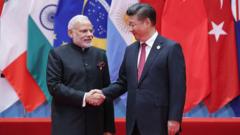In a backdrop of shifting global geopolitics, India and China are cautiously rebuilding diplomatic ties following years of border skirmishes. Recent high-level visits signal progress but significant challenges remain, underscoring the complexity of their relationship.
India and China Navigate Cautious Resurgence in Diplomatic Relations

India and China Navigate Cautious Resurgence in Diplomatic Relations
Amid ongoing territorial disputes, India and China are making slow strides toward repairing their historically fraught relationship while remaining vigilant against underlying tensions.
India and China, long embroiled in border tensions, are tentatively moving towards improved diplomatic relations as international dynamics shift. This change follows the recent visit of senior Indian officials to China, marking a notable thaw in interactions after years of strain.
The backdrop of this renewed engagement can be traced back to a longstanding dispute over a 3,440km border, fraught with skirmishes. In June 2020, violence escalated when Indian and Chinese soldiers clashed in Galwan valley, resulting in multiple fatalities for both nations. Despite ongoing tensions, both countries are finding common ground, evidenced by various agreements on trade and travel established in previous months.
India and China’s bilateral trade surged past $127 billion last year, positioning China as India’s second-largest trading partner. As the two look to resolve ongoing border issues, the necessity for peace is amplified to sustain and enhance economic ties. Recent collaborations, like restoring direct flights and easing visa restrictions, suggest a commitment to moving forward. However, underlying fears persist, particularly concerning China's burgeoning influence and assertiveness in the region.
Experts suggest that while India’s growing closeness with the US might complicate relations with China, both nations understand the necessity for stability. Events unfolding in the contested regions, including tensions with Pakistan, have also influenced India’s decision to approach China more openly.
Nonetheless, both parties must navigate numerous hurdles. For instance, China maintains aggressive posturing towards regions like Ladakh and Arunachal Pradesh, complicating dialogue. Moreover, China recently leveraged its economic power through restrictions on essential exports to India, raising alarms regarding its impact on industries reliant on these imports.
As India approaches relations pragmatically, the historical reluctance to concede over sovereignty remains a core barrier. While both countries engage in dialogues to weather current challenges, achieving lasting peace may require a readiness to compromise on long-standing territorial claims—a notion underscored by experts advocating for a resolution to contentious issues such as Southern Tibet. Balancing national interests against cooperative necessity appears critical as global power structures evolve, with India and China carving a pathway forward amid uncertain geopolitical landscapes.


















